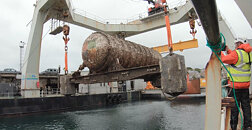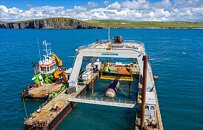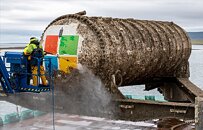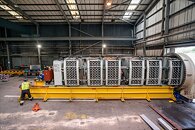Tuesday, September 15th 2020

Microsoft Underwater Data Center Initiative Project Natick Declared a Success After Two Years
Microsoft has announced it considers the result of its underwater data center initiative, named Project Natick, a success. This announcement comes after Microsoft recovered its data center capsule from the seafloor alongside the Orkney Islands after a two-year-long deployment. The self-contained server pod (made up of 12 racks and 864 servers) was filled with nitrogen, and achieved a much lower failure rate - component-wise - compared to traditional onshore data centers. In fact, its failure rate was one-eight that of traditional servers. The absence of oxygen and lower humidity levels (no need to keep air comfortable and breathable for human technicians) may have been deciding factors in this failure rate.
There are some obvious advantages from such an offshore server deployment. For one, all that cold water really helps in cooling down the components inside - there's no need for added expense in cooling solutions. There is also no need for land acquisition or infrastructure development that's typically associated with onshore server sites. The fact that Project Natick was fully powered by renewable energy sources, courtesy of the Orkneys' grid - supplied 100 percent by wind, solar, and experimental green technologies under development at the European Marine Energy Centre. considering its success, it can certainly be expected that Microsoft - and other companies - double down on this type of server deployment.
Source:
Ars Technica
There are some obvious advantages from such an offshore server deployment. For one, all that cold water really helps in cooling down the components inside - there's no need for added expense in cooling solutions. There is also no need for land acquisition or infrastructure development that's typically associated with onshore server sites. The fact that Project Natick was fully powered by renewable energy sources, courtesy of the Orkneys' grid - supplied 100 percent by wind, solar, and experimental green technologies under development at the European Marine Energy Centre. considering its success, it can certainly be expected that Microsoft - and other companies - double down on this type of server deployment.




26 Comments on Microsoft Underwater Data Center Initiative Project Natick Declared a Success After Two Years
As someone who was certified to design data centers, this is pretty cool!!!
I'm also concerned with constantly dumping 10s of thousands of watts into the ocean that is already warming.....but that is another story.
Maybe 1 server will not be enough, but multiple could be a challenge for environment certifications.
I guess one way could be creating artificial lakes for this type of projects.like upgrading a satellite, send a new one into orbit.
azure.microsoft.com/en-us/blog/monitoring-environmental-conditions-near-underwater-datacenters-using-deep-learning/Phase 2 (what they finished) was done with 100% renewable energy. There were some interesting articles and FAQ's here:
natick.research.microsoft.com/
The most important thing to remember here is that something like 50% of the energy used in data centres is to cool the data centres. If this means we cut our power used in half then that's a massive win for global sea temps.It was a few years ago but almost certain they were the numbers.
But as I say, it was a few years ago so maybe I am remembering it wrong.